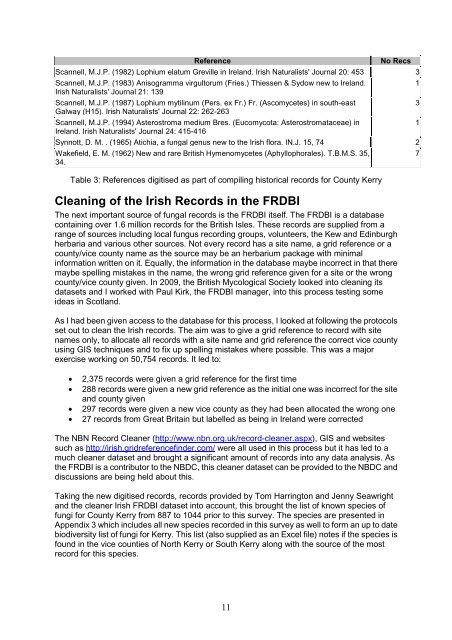North Kerry Waxcap Survey 2012 - the Northern Ireland Fungus Group
North Kerry Waxcap Survey 2012 - the Northern Ireland Fungus Group
North Kerry Waxcap Survey 2012 - the Northern Ireland Fungus Group
You also want an ePaper? Increase the reach of your titles
YUMPU automatically turns print PDFs into web optimized ePapers that Google loves.
Reference No Recs<br />
Scannell, M.J.P. (1982) Lophium elatum Greville in <strong>Ireland</strong>. Irish Naturalists' Journal 20: 453 3<br />
Scannell, M.J.P. (1983) Anisogramma virgultorum (Fries.) Thiessen & Sydow new to <strong>Ireland</strong>.<br />
Irish Naturalists' Journal 21: 139<br />
Scannell, M.J.P. (1987) Lophium mytilinum (Pers. ex Fr.) Fr. (Ascomycetes) in south-east<br />
Galway (H15). Irish Naturalists' Journal 22: 262-263<br />
Scannell, M.J.P. (1994) Asterostroma medium Bres. (Eucomycota: Asterostromataceae) in<br />
<strong>Ireland</strong>. Irish Naturalists' Journal 24: 415-416<br />
Synnott, D. M. . (1965) Atichia, a fungal genus new to <strong>the</strong> Irish flora. IN.J. 15, 74 2<br />
Wakefield, E. M. (1962) New and rare British Hymenomycetes (Aphyllophorales). T.B.M.S. 35,<br />
34.<br />
Table 3: References digitised as part of compiling historical records for County <strong>Kerry</strong><br />
Cleaning of <strong>the</strong> Irish Records in <strong>the</strong> FRDBI<br />
The next important source of fungal records is <strong>the</strong> FRDBI itself. The FRDBI is a database<br />
containing over 1.6 million records for <strong>the</strong> British Isles. These records are supplied from a<br />
range of sources including local fungus recording groups, volunteers, <strong>the</strong> Kew and Edinburgh<br />
herbaria and various o<strong>the</strong>r sources. Not every record has a site name, a grid reference or a<br />
county/vice county name as <strong>the</strong> source may be an herbarium package with minimal<br />
information written on it. Equally, <strong>the</strong> information in <strong>the</strong> database maybe incorrect in that <strong>the</strong>re<br />
maybe spelling mistakes in <strong>the</strong> name, <strong>the</strong> wrong grid reference given for a site or <strong>the</strong> wrong<br />
county/vice county given. In 2009, <strong>the</strong> British Mycological Society looked into cleaning its<br />
datasets and I worked with Paul Kirk, <strong>the</strong> FRDBI manager, into this process testing some<br />
ideas in Scotland.<br />
As I had been given access to <strong>the</strong> database for this process, I looked at following <strong>the</strong> protocols<br />
set out to clean <strong>the</strong> Irish records. The aim was to give a grid reference to record with site<br />
names only, to allocate all records with a site name and grid reference <strong>the</strong> correct vice county<br />
using GIS techniques and to fix up spelling mistakes where possible. This was a major<br />
exercise working on 50,754 records. It led to:<br />
• 2,375 records were given a grid reference for <strong>the</strong> first time<br />
• 288 records were given a new grid reference as <strong>the</strong> initial one was incorrect for <strong>the</strong> site<br />
and county given<br />
• 297 records were given a new vice county as <strong>the</strong>y had been allocated <strong>the</strong> wrong one<br />
• 27 records from Great Britain but labelled as being in <strong>Ireland</strong> were corrected<br />
The NBN Record Cleaner (http://www.nbn.org.uk/record-cleaner.aspx), GIS and websites<br />
such as http://irish.gridreferencefinder.com/ were all used in this process but it has led to a<br />
much cleaner dataset and brought a significant amount of records into any data analysis. As<br />
<strong>the</strong> FRDBI is a contributor to <strong>the</strong> NBDC, this cleaner dataset can be provided to <strong>the</strong> NBDC and<br />
discussions are being held about this.<br />
Taking <strong>the</strong> new digitised records, records provided by Tom Harrington and Jenny Seawright<br />
and <strong>the</strong> cleaner Irish FRDBI dataset into account, this brought <strong>the</strong> list of known species of<br />
fungi for County <strong>Kerry</strong> from 887 to 1044 prior to this survey. The species are presented in<br />
Appendix 3 which includes all new species recorded in this survey as well to form an up to date<br />
biodiversity list of fungi for <strong>Kerry</strong>. This list (also supplied as an Excel file) notes if <strong>the</strong> species is<br />
found in <strong>the</strong> vice counties of <strong>North</strong> <strong>Kerry</strong> or South <strong>Kerry</strong> along with <strong>the</strong> source of <strong>the</strong> most<br />
record for this species.<br />
11<br />
1<br />
3<br />
1<br />
7


